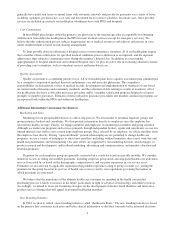Health Net 2003 Annual Report Download - page 21
Download and view the complete annual report
Please find page 21 of the 2003 Health Net annual report below. You can navigate through the pages in the report by either clicking on the pages listed below, or by using the keyword search tool below to find specific information within the annual report.In May 2001, we appointed Computershare Investor Services, L.L.C. to serve as the Rights Agent under the Rights
Agreement.
The foregoing summary description of the Rights does not purport to be complete and is qualified in its entirety by
reference to the Rights Agreement, which is incorporated by reference in Exhibits 4.2, 4.3 and 4.4 to this Annual Report
on Form 10-K.
Potential Divestitures
We continue to evaluate the profitability realized or likely to be realized by our existing businesses and operations.
We are reviewing from a strategic standpoint which of such businesses or operations, if any, should be divested.
Risk Factors
This discussion and analysis and other portions of this Annual Report on Form 10-K contain “forward-looking
statements” within the meaning of Section 21E of the Securities Exchange Act of 1934, as amended, and Section 27A of
the Securities Act of 1933, as amended, regarding our business, financial condition and results of operations. These
forward-looking statements involve risks and uncertainties. All statements other than statements of historical information
provided or incorporated by reference herein may be deemed to be forward-looking statements. Without limiting the
foregoing, the words “believes,” “anticipates,” “plans,” “expects,” “may,” “should,” “could,” “estimate” and “intend” and
other similar expressions are intended to identify forward-looking statements. Managed health care companies operate in
a highly competitive, constantly changing environment that is significantly influenced by, among other things, aggressive
marketing and pricing practices of competitors and regulatory oversight. Factors that could cause our actual results to
differ materially from those reflected in forward-looking statements include, but are not limited to, the factors set forth
below and the risks discussed in our other filings from time to time with the SEC.
We wish to caution readers that these factors, among others, could cause our actual financial or enrollment results to
differ materially from those expressed in any projections, estimates or forward-looking statements relating to us. In
addition, those factors should be considered in conjunction with any discussion of operations or results by us or our
representatives, including any forward-looking discussion, as well as comments contained in press releases, presentations
to securities analysts or investors or other communications by us. You should not place undue reliance on any forward-
looking statements, which reflect management’s analysis, judgment, belief or expectation only as of the date thereof.
Except as may be required by law, we undertake no obligation to publicly update or revise any forward-looking
statements to reflect events or circumstances that arise after the date of this report.
Our profitability will depend, in part, on our ability to accurately predict health care costs.
A substantial majority of the revenue we receive is expended to pay the costs of health care services or supplies
delivered to our members. The total health care costs we incur are affected by the number and type of individual services
provided and the cost of each service. Our future profitability will depend in part on our ability to accurately predict health
care costs and to control future health care costs through underwriting criteria, utilization management, product design
and negotiation of favorable professional and hospital contracts. Changes in utilization rates, demographic characteristics,
the regulatory environment, health care practices, inflation, new technologies, clusters of high-cost cases, continued
consolidation of physician, hospital and other provider groups and numerous other factors affecting health care costs may
adversely affect our ability to predict and control health care costs as well as our financial condition, results of operations
or cash flows. Periodic renegotiations of hospital and other provider contracts, coupled with continued consolidation of
physician, hospital and other provider groups, may result in increased health care costs or limit our ability to negotiate
favorable rates.
The managed health care industry is labor intensive and its profit margin is low. As such, it is especially sensitive to
inflation. Health care industry costs have been rising annually at rates higher than the rate of increase of the Consumer
Price Index. Increases in medical expenses or contracted medical rates without corresponding increases in premiums could
have a material adverse effect on us.
We face competitive pressure to contain premium prices.
In addition to the challenge of controlling health care costs, we face competitive pressure to contain premium prices.
While health plans compete on the basis of many factors, including service and the quality and depth of provider
19
























